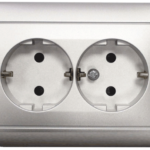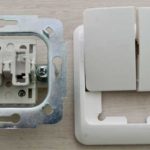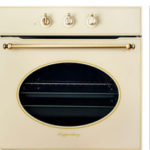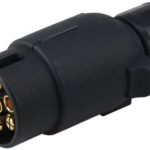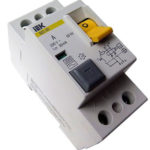Proper connection of the electric stove with regard to the necessary standards is required for efficient operation and increased service life. It is possible to have a specialist connect the power, but you can do the work yourself and save money. Studying the instructions that come with the unit will help you avoid mistakes and unpleasant consequences. When connecting the electric stove with your own hands, take into account the normative characteristics of appliances, wires, sockets and plugs.
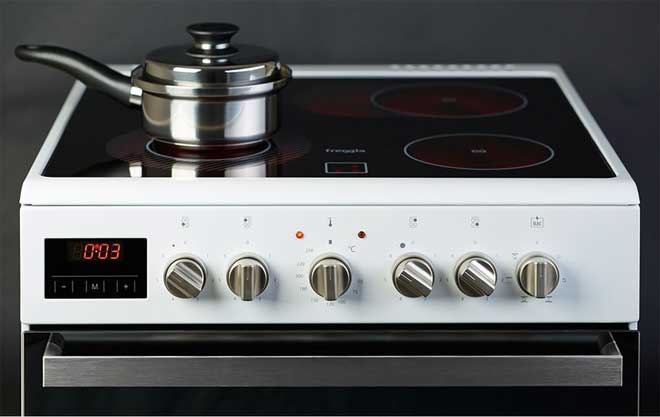
Contents
Requirements for parameters and ratings of circuit breakers
Household electric stoves are a powerful type of equipment that uses a current of 40 to 50 A to work. They are connected to a separate cable directly fed from the house switchboard. Electricity is fed through a circuit breaker and RCD. The unit itself is connected through the plug and socket, as well as the terminal box. The branch from the circuit breaker is connected directly to the terminals located on the wall behind the heater.
A residual current device (RCD) is a device to energize and disconnect power under certain conditions when the differential current reaches specified parameters. It protects people and animals against electrocution in case of small damages of insulation and current-carrying phase conductors.
In the switchboard is dialed a set of circuit breaker RCD, from here comes the voltage to the socket. Sold designs that combine the functions of 2 devices in one device. Minus is connected to the common bus, and grounding goes to the appropriate contact.
Rated automatic unit is selected by the consumption current. The figure is in the passport of the furnace and is 40 - 50 A. For operation in such a range, protective devices are presented in 3 ratings:
- 63 А;
- 50 А;
- 40 А.
It is recommended to take a power device with a higher rating. This will help to avoid regular shutdowns during full load operation. If in the passport the maximum stated consumption is 42-44 amps, then the protection take 50 amps. The equipment may not always work at full power, for this all burners and the oven must function, but it is better to reinsure.
The optimal value for the choice of RCD is the current limit higher by 1 step from the characteristics of the circuit breaker. If the device is installed 50A, then you need a protection device for 63A, and the leakage current is calculated at 30 mA.
To increase reliability, the stove is connected directly to the input terminals, with the minimum number of contact points involved. Termination is carried out only a circuit breaker, which is inconvenient. Often the oven is connected with a plug and socket, which is more familiar. Power pairs are used for this purpose, household pairs are not suitable.
The wire and its parameters
Modern cooktops for installation in the apartment are sold without a cord. The set serves as a guarantee that the devices are docked by means of clamping pads. In this case, the length of the supply cable is increased, the circuit breaker is changed to a fusible link. The cross-section is chosen depending on the length:
- if the length of the wire does not exceed 12 m, it is enough to take a cable with a cross-section of only 4 mm²;
- if extending the power cord requires a figure of 6 mm².
These are generalized values, because the characteristic changes up or down when you change the power. For 7 kW ovens use a 3x4 cable, the line is equipped with a circuit breaker 25 A. The choice of the number of wires depends on the variant of phase connection:
- single-phase circuit is performed using three-core electrical wire;
- Two-phase and three-phase connections are made using a five-core cable, which has a cross section of at least 2.5 mm² and supplies equipment up to 16.4 kW.
A five-core cable with these ratings is suitable for all residential electric ovens. When wiring the power to the socket, a single-core wire with factory-insulation is used, as it is reliable, despite its rigidity. Because of the latter characteristic, it is not used for wiring to the clamps on the back wall, as it is inconvenient to do so.
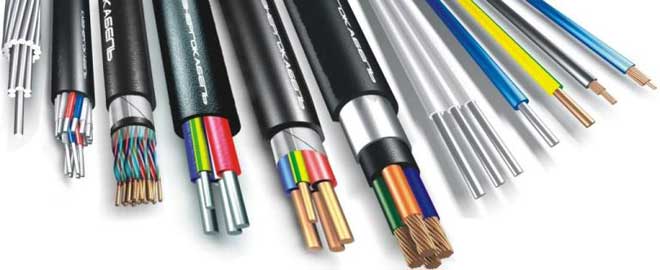
For laying from the junction box to the stove, the cable grades are taken:
- VVG;
- PVS;
- VVG-ng;
- VVG; PVG-ng.
To connect to the socket use flexible wire KG, characterized by resistance to cracking when bent.
Diagram and wiring methods
Single-phase connection of the stove is common. To connect the electric stove by this method, terminals 1,2,3 and then 4,5 are united by copper jumpers with a cross section greater than 6 mm². These elements are included in the sales kit. The phase conductor is colored black, brown or gray and connects to terminal 1, 2 or 3. The blue colored neutral wire should be connected to terminal 5 or 4. The green color ground braid is attached to pin 6.
The bolts should be tightened firmly, as poor connection will lead to burning of the insulation and fire. In the version of the connection diagram of the electric stove when powered from the socket phase wire is attached to terminal L, zero goes to terminal N. The ground conductor is connected to the appropriate terminal, which is shown in the grounding diagram, with the letters PE.
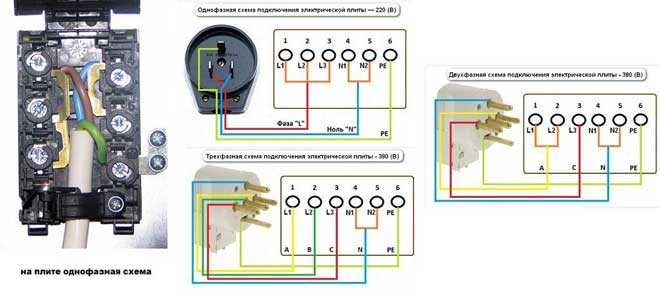
A two-phase circuit is rarely used. Before you can properly connect the heater, you must determine that phase B is not used, there are only A and C. Copper jumper short-circuit terminals 1, 2, they are attached to the working wire A, phase C goes to terminal 3. Further connection is similar to the single-phase method. Two-phase scheme is used in private buildings, but in apartments this option is not excluded if the wiring is made by a four-core cable. Proper connection of the wires:
- yellow wire goes to terminals L1 and L2, connected by a jumper - phase A;
- red wire is attached to the terminal L3 - operating circuit C;
- blue braid is connected to the zero contact - zero circuit;
- green - grounding.
On the plug in this version there are 4 horns.
The hob and oven are connected in a three-phase scheme, the way is used as a variant of electric stove connection in private households or multi-storey buildings of the old type. Take a 4- or 5-wire wire, and between the phase and zero voltage of 220 V, and in the middle of the working phases indicator 380 V. Connection is made in the following order:
- The conductors under voltage C, B, A are attached to the terminals with the numbers 3, 2 and 1, respectively;
- terminals 5, 4 and 6 are connected as in the single-phase version.
How to connect to 220 V?
To connect an electric stove, first determine the place of installation in the picture. A plug socket is mounted near the stove on the nearest partition or wall and connected to the ground. The current rating of the device is between 25 and 40 A. Three-phase network socket has 5 terminals. In the switchboard for the stove is provided separately circuit breaker, requires a three-way switch rated at 16A.
To connect take a wire, socket and plug. Different models of household stoves are docked similarly, differing only in the form of protective covers on the back wall. When connecting the stove to a single-phase network, you need to run the cable to the socket in accordance with the chosen scheme and close the top cover.
Connecting the cable to the electric stove
When using a three-core wire, the brown braid goes to the phase connector of the socket, the blue wire is docked to the zero contact, the green-yellow wire is attached to the grounding terminal. The phases of the five-core wire are white, brown, and red.
The cable is connected to the tile by means of a terminal board on the rear surface of the equipment. The standard wiring diagrams for the different types of mains are plotted next to each other. For the 220V line, the outermost drawing on the right is used. A jumper is put on the first 3 pins, you get the phase (brown and red wires). Connectors 5 and 4 are neutral or neutral-zero (blue or blue colored strands). The grounding current flows through the braid in green.
Jumper wires are often factory installed, but when connecting the cooktop, check with a screwdriver and indicator light. The wire ends are tinned before docking to ensure good contact.
Plug Installation
The plug is docked to the soft wire of the cooker hob, respecting the markings on it. Connecting the wires by color is done in the same way as it was done in the socket. The power plug is always disassembled by removing the 2 screws, cover and fixing strip. The edges of the conductors are stripped of insulation and fastened with bolts. It is necessary to install the socket and connect the plug, so that the top contact of the green color - grounding.
It is necessary to achieve a match zero and phase on the socket and plug, otherwise there will be a short circuit. Before turning on the power supply, once again check the correct attachment of wires. If the connection of the heater is made in an already prepared socket, the wire with the load, zero and ground are determined, and in the equipment connection is made in accordance with the existing manual.
The rated current of the socket is 7 kW, this is a disadvantage in some cases, because the total power when you turn on all the burners and the oven exceeds the figure. This puts the socket - plug pair out of order after a short period of use. To prevent this, they take devices from Belarusian manufacturers, which can simultaneously withstand up to 10 kW of power.
Connection to a three-phase network of 380 V
This option is advantageous, because it reduces the consumption of metal on the supply wires. Most of the cooking units with high power hobs are included in single-phase wiring without modification. It is allowed to connect to 2 working wires, but it is recommended to use 3 contacts three-phase network 380. This reduces the load on the electrical panel devices.
Powerful stoves that require this circuit are installed in institutions or private buildings with three-phase inputs rated at 360 V. A five-core cable with a minimum cross section of 2.5 mm² is used. Before you connect an electric stove to a three-phase socket, take a plug with 5 wires. On the terminal board, remove the jumper from the terminals L2, L3, L1 and attach the working wires to these terminals.
In the case of connecting the oven with their own hands leave intact jumper between terminals 5 and 4, and at terminal 6 fix grounding. Circuit breaker and RCD device is purchased for three-phase network, the cable take five-core. The socket and plug are bought with 5 pin terminals.
Connection is made by two or three-phase method, the connection process differs only in the number of phase wires, which are differently connected to the output terminals on the pad of the stove. The connecting wire is thrown only on terminals 6 and 5, the others are connected with separate wires. It is not necessary to match the colors of the phase conductors, because this does not upset the functionality.
For two-phase connection you can take a socket with 4 pins. On foreign equipment there is a wiring diagram without the use of a zero. This option is provided only for America and is not used in our network, as the voltage in the line must be 110 V.
Related articles:
